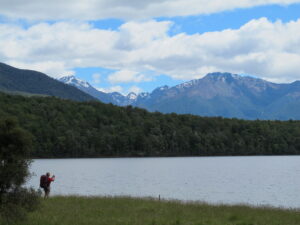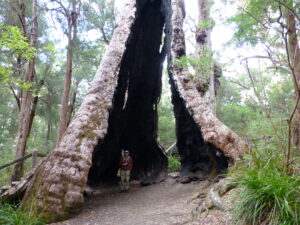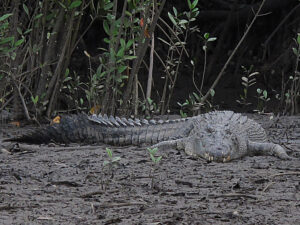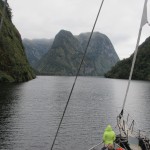
In 1770, Captain James Cook, the historically inescapable Englishman who first explored New Zealand, sailed past the many fjords, or sounds, of southwestern New Zealand, an area now appropriately called Fjordland. At one of those narrow ocean inlets hemmed in by steep hills, he feared that the prevailing offshore winds might not allow him to get back out or even navigate well within. In his typically direct method, he simply called it Doubtful Sound.
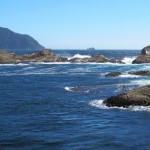
Twenty three years later, the Spanish captain Alessandro Malaspina sent a longboat into Doubtful Sound to avoid Cook’s concern, but after a very brief stay in the shadow of the steep cliffs amid the relentlessly biting sand flies, they departed for Australia instead. Soon seal hunters arrived to harvest the plentiful fur seals here for their oil and skins, but they stayed on the outer reaches rather than the interior.
Contemporary tourists need not be so hesitant about venturing into Doubtful Sound or the others in the area, all contained within Fjordland National Park. Several tour companies have hauled modern vessels into them, complete with radar and powerful diesel engines and modern conveniences. We just travelled into Doubtful with the sole operator there, the excellent Real Journeys. Others go to different sounds, most notably Milford whose fame draws visitors like, well, sandflies to your skin.
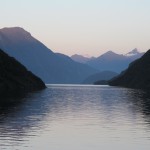
You can book yourself into a day cruise on these ships or, like us, stay overnight and enjoy the considerable splendors of the Sounds over an afternoon, extended daylit evening and long, lazy morning. Safety and comfort define a visit there now, unless you’re one of the few kayakers that experience them paddle stroke by paddle stroke, camping on the sandy coves.
Bus, boat, bus, boat, it says on the itinerary, but the trip is hardly tedious. Rumbling out of the nearest town Te Anau on the first bus, we passed along a broad valley lined with snow-tipped misty blue mountains. We had walked some of this terrain on the Kepler Track and the Lake Te Anau circuit the day before, but the bus revealed more and more spectacular vistas as we rode.

Then, for an hour or so, we crossed the length of Lake Manapouri where the passengers shifted continually around the small cruise boat, squeezing by the rail for pictures and the ever-changing landscape: lush islands, dozens of peaks up-valley set against impossibly blue skies and picturesque waterfalls coursing through granite rifts and glacially carved hillsides. This boat trip ended at another curiosity some tourists like to visit, a huge hydro plant built in the 60s to power an aluminium smelter at the very south end of the South Island 171km away. It generates power from the outflow of lake water with machine works dug 2km deep in the rock.

Then by bus again spiraling through the mountains along the dusty road of Wilmot Pass, the only passage from Doubtful Sound to the rest of the world. Along the way, we stopped to view three permanent waterfalls cascading from high above the pass, as well as the site of those temporary ones that flood the road when it rains. As we began our descent into the sound, we stopped again for a thrilling overview of the inlet, cameras clicking and buzzing all around us.

Our cruising boat reminded us of a smaller version of the ship we took to Antarctica. This one housed around 80 people plus crew, some in comfy twin rooms with bathrooms, some in quad-share rooms (though likely a lot more appealing than the shared galleys for Captain Cook’s crew). But most of us spent little time in our rooms, with our picturesque transit through the sunlit hills that define this inlet.

As we moved westward from the end of the Sound to the Tasman Sea, the strong westerly wind was a bit chilly, but most of us stayed on deck anyway as every few minutes a new tableau slipped by: stunning contrasts of dark waters and green hills or distant coronas of snowy mountains or inviting watery arms of the sound. We eased into several of these side inlets and bays on our way to the ocean, then closely approached the narrow rocky passages and squat seal-inhabited islands near the mouth of the inlet. There, we oohed and aahed over the hundreds of momma fur seals and babies we saw.
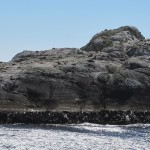
Turning back to the east, we nestled in one quiet bay, as the setting sun started to add tincture to the hillsides. There about half of us plopped into kayaks so we could paddle for an hour or so, edging close to the waves that sucked against the rocks and peering into caverns cut into the shoreline. Afterwards, with a handful of others, Nancy even took a quick dip into the water, a cool mid-50s Fahrenheit in temperature -a very quick dip.
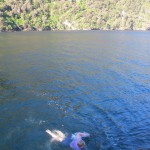
In our kayaks, like Malaspina’s crew, we attracted those legendary pesky sandflies from the shore. Sand flies are a constant source of humor here, commensurate with their annoyance. “I hope you didn’t get bitten by sand flies while you were here; you know, it’s illegal to feed the wildlife in the national park.” The after-dinner lecturer on the ship alluded often to their history of annoying explorers, natives, whalers and others who dared to tread here, even while a dozen or so sandflies danced innocently in the light of the slide show. Smaller than mosquitoes, they leave massive welts that will drive you itching crazy for up to a week, even if you’re not particularly allergic. Whenever we neared shore in the kayaks, we found ourselves swatting away the flies as much as paddling. Nancy was sure they were making a nest in her hair; Barry wished he had brought his hat. Only pulling into a breeze or paddling far enough from shore stopped their harassment.

Nonetheless, even with a few souvenir bites, getting onto the water was well worth the battle. You feel the landscape much differently so close to the surface, as the hills loom higher and there is no barrier between you and the raw beauty of the place. We were surprised by the diverse ways the water and land interacted and by the subtle tidal action unobservable from atop the cruise boat. Birds hidden in the bush sang a delightful chorus unheard till now.
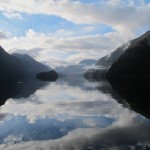
But a cruise is not just about what you see; even a short one allows you the pleasure of meeting interesting people. It’s surprising, really, how fast you can gather a congenial circle. Ours included an energetic teacher from Hanover Germany on sabbatical for a year, an American couple from Northern California, a willowy woman from Perth, the cruise naturalist, and a few others that they “friended” along the way. Conversations tend to cover travelling done and anticipated, but the most interesting ones explore our cultural differences and attitudes. For the two of us, this engagement with fellow travelers often proves just as memorable as any sight.
Later, dusk and dark descended, first projecting gaudy reflections of the hillsides onto the water, then gradually lighting up the Milky Way and all the constellations of the southern sky. We hungrily fed from the manifold buffet, learned about sandflies and the Sound’s history from the naturalist, and soon crept to bed.

With the churn of the engines and cranking of the anchor at 6:15am, the ship began to move about the inner arms of the Sound. This morning some fog and mist decked the hills, but that change from sunshine just added to the charm and wild atmosphere of the place.

Occasionally we neared the banks for the naturalist’s lessons on geology and plant-life, while we searched the banks in vain for the penguins that reputedly depart each year a day or two after our visit. Other island and mountain vistas opened up as we proceeded. Then suddenly there they were, a pair of Fjordland Crested Penguins swimming and dipping in the distance; soon three more came close to the boat like an inspection crew. Cameras whirred and buzzed.
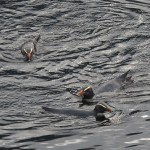
It seemed somewhat extraordinary that a high class tour boat would dawdle over a few penguins, or sidle up to an island for a lesson on flora, but it’s run by Kiwis after all, people who love the natural wonders of their land and are eager to share it with travelers. And that’s why they shared a very special stop with us before we headed home. The ship eased to the end of Hall Arm, one of the grandest of the Sound’s side inlets. Then for about ten minutes, we were told to stop – engines off, cameras still, no movement – and just be in the landscape. The high green funnel of land we faced, carved by glaciers ages ago, fell silent. Or rather filled with the noise of bird song and its vertiginous waterfall. Forced to stop being tourists, together we felt a profound attentiveness that most people never halt long enough to experience. Stop, look and listen, the crew was reminding us, to experience this grandeur truly.
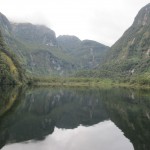
Sadly now, as the engines churned and cameras clicked once again, we were pulled back into the tourist bustle – docking and disembarking from the ship, then again on the bus, boat, bus – for our return to another world.
(Also, for more pictures from New Zealand, CLICK HERE to view the slideshow at the end of the New Zealand itinerary page.)



